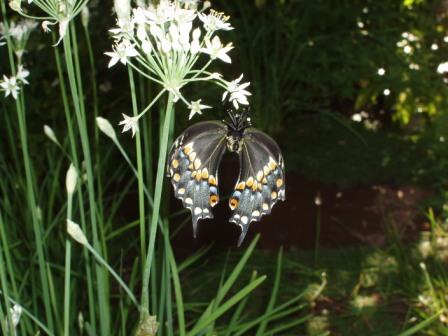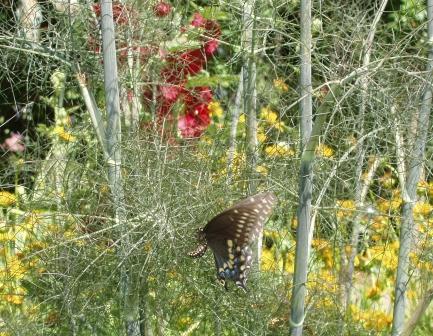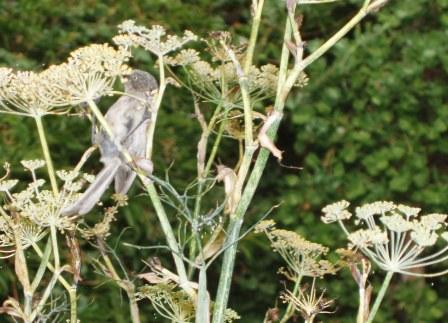
Gardeners can reap rewards
by going 'no-kill'
All kids love bugs, or at least love messing with them. Yet somewhere between crawling and skateboarding, kids learn that bugs bite and sting, bugs teem and slime, bugs ultimately will eat your beautiful roses. That’s why the adult homeowner, when confronted with a bug (or, heaven forbid, a hundred of them) thinks immediately of how to get rid of them. Now.
Not so fast—especially not in the garden. Among bugs as among people, there are good guys and bad guys, and it’s important to know the difference so the good bugs will keep coming back to feast on your aphids and mealybugs. Many gardeners shy away from using insecticides anyway because they are toxic to humans and pets. But there are other reasons to pause before smashing, stomping, hosing, or stripping your yard of bugs.
Nature, we often forget, tends toward balance when not disturbed. An excess of one creature will attract predators, which then naturally decline as prey grow scarce. Because modern humans are so quick to reach for an artificially engineered solution—be it chemical fertilizer or broad-spectrum insecticide—we tend to witness the opposite of equilibrium: one problem after another in the garden.
“If I could encourage people to do anything, it’s to sit back and watch,” says Wes Brittenham, a veteran Albuquerque gardener, landscaper, and manager at Plants of the Southwest. “Simply by observing, I’ve learned how little I need to do, how little I need to spend.” Brittenham says he has not bought garden products (although he sells them) for two decades, because he has learned to work with nature and harness natural solutions. One of the simplest, most effective ways to keep your garden healthy is to do everything possible to attract good bugs and other predators to do the dirty work for you.
1. Increase diversity
When humans started practicing agriculture (which was really monoculture), pests immediately became a problem. Planting an acre of the same crop is like setting out a banquet for bugs that favor that crop. It follows, then, that the first defense of a healthy garden is diversity—a little of everything and not too much of anything.
“Plant flowers amongst your crops. Or allow some of your vegetables to bolt and make flowers. Don’t harvest all your carrots, for example, so they make flowers,” advises Cheryl Kent, horticulture agent for the Bernalillo County Cooperative Extension office of New Mexico State University (NMSU). “Flowers attract beneficial insects. Many bugs are predators in their larval stage, and the adults are pollinators.”
It’s in the larval stage, in other words, that many good bugs do their useful work—which is why you don’t want to indiscriminately knock all the aphids off your plants with a hose. The delicate larvae of green lacewing and the tiny eggs of ladybugs congregate wherever aphids, their primary food source, are found. Not only will you have knocked out the good guys, but aphids themselves serve as an important lure, so you always want to leave a few around. Kent calls them “nature’s hamburger.”
The general rule of favoring diversity applies not only in your vegetable garden, but also throughout the yard. Brittenham notes that some orchard farmers, instead of planting grass, will put in plants that serve multiple purposes—alliums like onion and garlic to keep away pests, nitrogen-fixing plants to nourish the soil, borages to aerate. Of course this doesn’t make for as romantic a spot to woo your sweetheart under the peach tree as a uniform carpet of grass. (See “Plant, and They Will Come,” below.)
A black swallowtail butterfly lays eggs on a fennel plant, one of the most useful
plants in the garden. Fennel also attracts ladybugs, lacewings, and bushtits.

2. Amend the soil
Southwest gardeners are not blessed with naturally rich soils, either on mesa sand or bosque clay. In former days, when the Rio Grande regularly overran its banks, organic debris would enrich soils across the floodplain. Channels and arroyos built to prevent flooding put an end to that. Unfortunately, most soils in our area have long been stripped of nutrients.
Healthy soils play the same role for plants as a strong immune system in humans, fighting off disease before it does damage. That’s why you want to cultivate another type of good bug underground: bacteria and fungi, the bugs you can’t see.
“It’s the most important part of the garden,” and often disregarded, says Brittenham. “Chemical fertilizers are too high in salts, and kill micronutrients in the soil.” Using them is like feeding people a ton of vitamins, but no real food.
To build up healthy soils, bring in as much organic matter as possible to nourish microscopic bugs: compost, mulch, unraked leaves, organic fertilizers like sugar, alfalfa meal, rock phosphate, kelp, or fish emulsion. Don’t mix these in, Brittenham adds, but simply lay them on top, to mimic dead leaves, and add water. Microorganisms thrive in the zone where ground meets matter. Again, this is not going to make your garden look as picture-perfect as the magazine centerfolds.
3. Reduce or eliminate use of chemicals
It’s not only toxic pesticides that destroy your efforts to fortify your garden. Even “safe” or “natural” products like Neem oil kill indiscriminately, since a product’s safety refers to its effect on humans, not on ladybugs or praying mantids (both of which are your friends). Spiders, damsel flies, certain assassin bugs, and some ground beetles also should be cared for, either because they eat pests, or attract the birds that do.
If you really must use some product in the garden, choose the least toxic and most targeted available, says Kent, to reduce the possibility of “friendly fire.” Among the pests most likely to drive gardeners to reach for the heavy arsenal are squash bugs and harvester ants, which both lack significant predators and do serious damage quickly. For harvester ants, Brittenham uses a boric acid bait. For squash bugs, the best defense seems to be early detection and physically destroying bugs, eggs, and larvae.
“This is a case where the situation can get out of hand in days, and your only choice will be to pull out the plant,” Kent says of the ubiquitous squash bug. “Monitor squash plants by looking under the leaves for the clusters of reddish-brown eggs, as well as the bugs themselves. Physically squish them with your gloves and a bucket of soapy water. If you have a leaf covered in them, just pluck it.”
Once a squash plant is infested, one recommended technique is to lay wooden boards around the base of the plant and wait for the bugs to climb down at night and burrow underneath. At dawn, lift the boards and Shop-Vac the little pests away.
“Trying to catch things early is so important,” notes Kent, “because sometimes it is too late. That means walking around your garden and looking under leaves. You’ll notice problems developing much quicker and have time to jump on them.”
A bushtit visits a fennel plant. Bushtits are a godsend in the garden
because they love to feast on small insects.

4. Know your pests
With the exception of squash bugs, the best course of action, organic gardeners say, is inaction. Plants, like humans, are strengthened by adversity and will come back stronger next year. In the meantime, crops may be lost, flowers may die, and your garden may not look very tidy. But in the long run you both will be healthier if you do less.
When you do find an unwelcome bug in the garden, start by figuring out what it is. Bring a sample to one of the NMSU cooperative extension offices during normal working hours, and an agent will either identify the species or get back to you. (As trained horticulturists, extension agents are less hit-and-miss than either garden center staff or Master Gardeners.) The Sandoval County office is at 711 S. Camino del Pueblo in Bernalillo; in Albuquerque, the Bernalillo County office is at 1510 Menaul Blvd. NW.
Once the bug is identified, ask yourself if it really needs to be dealt with right now, or if you can afford some watchful waiting. Can the intruder be removed physically? Only after all other avenues have been considered should you reach for a commercial product—not as a first response, as is our usual instinct.
“Take the long view,” advises Brittenham. “Sometimes leaves will get stripped, and then the pests leave. In the meantime, they attract predators. Just leave things be, and everything shows up in balance. Over the long run, this approach is safer for the garden and for humans.”
The good bugs in your garden will reward you for it.

Plant, and they will come
A customized menu of annuals for friendly local bugs
Many gardening guides found online or in books recommend plants that don’t do well in the arid Southwest. At New Mexico State University’s Agriculture Science Center in Los Lunas, Tessa Grasswitz experiments with farming techniques suitable to our climate and soils. Grasswitz is an expert in integrated pest management, which applies biological knowledge about pests to manage them in the most economical, least hazardous way available.
Grasswitz has found a number of bugs in our area that are beneficial to farms and gardens, including various parasitic wasps and flies, minute pirate bugs, hoverflies, green lacewings, ambush bugs, ladybugs, crab spiders, and predatory mites. Planting to provide nectar and pollen to a wide range of bugs all season long will not only attract insect friends, it will help sustain them when prey grow scarce.
Rather than buy a premixed flower seed, many of which do not perform consistently here, Grasswitz recommends the following cheap, easy-to-grow annuals, some of which are not native but are easy to find and grow. All should survive in both sandy and clay soils, providing a continuous bloom from late June to early October. Feel free to add more single-flowered species (adjusting seed rates accordingly), as long as they are not in the same family as other plants in your garden, so you don’t start attracting too many pests specific to that family.
California bluebell: Phacelia campanularia
Buckwheat: Fagopyrum esculentum (but not in sandy soil susceptible to root rot)
Dill: Anethum graveolens
Plains coreopsis: Coreopsis tinctoria
Garden cosmos: Cosmos bipinnatus
Sweet alyssum: Lobularia maritima
Sow seed in spring after the last frost and before planting the rest of the garden. Mix seed with dry peat and scatter by hand, mixing lightly into soil before watering. Most important, use double the recommended seed rate, and divide by the total number of species in the mix.
